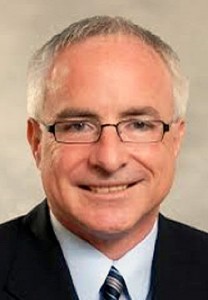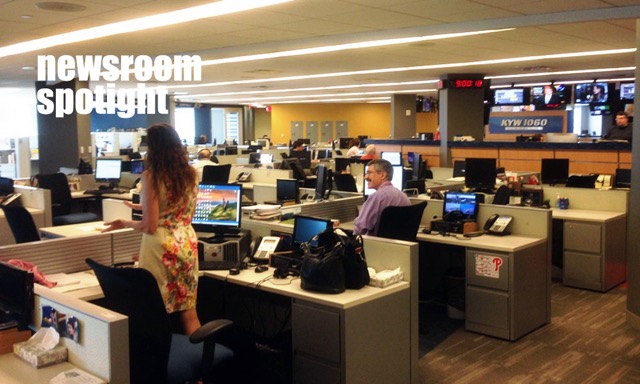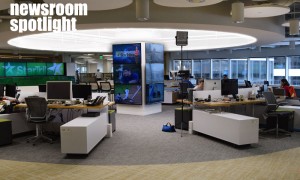Editor’s Note: This Q&A is part of “Newsroom Spotlight,” a series of conversations with journalists about what’s going on in their newsrooms and the media industry. The interview excerpts have been lightly edited and organized for clarity.
Steve Butler, director of news and programming at KYW Newsradio, has spent most of his career dialed in to covering Philadelphia-area news via the radio.
He remembers assembling Saturdays at KYW with other local high school kids back in 1974 for broadcast journalism classes; while studying at Temple University, he was a desk assistant in the KYW newsroom; a year after college, he was covering city hall and transportation as a reporter.
With brief stints at other radio and TV operations and a radio industry trade magazine, Butler, 59, has returned thrice to KYW, where he has led news and programming since 1996. He deploys a crew of about 70 to cover the City of Brotherly Love around the clock. The split is about 33 full timers and another 30 to 35 part-timers.
About a year ago, KYW’s team joined its CBS TV brethren in a combined newsroom. Now, sometimes to avoid duplicative efforts, the radio reporters and TV types might do a story for the other’s platform. “Anything we can do to make [news coverage] more intense is only good for us,” says Butler, who also holds a vice president title with CBS Corp.’s all-news radio stations.
American Journalism Review: Tell us about the size of your newsroom operation—how many employees are on the editorial staff, and how much news do they produce for various channels?

Steve Butler directs news and programming for KYW Newsradio in Philadelphia and is VP/Radio News for the eight all-news CBS station group.
Steve Butler: We are live with all news, 24 hours, seven days a week. We don’t have any other programming – any talk or any other type of news programming. [Our stories typically] are a maximum of 45 seconds – generally a tight, fast-moving wheel of news 24 hours a day.
It’s streamed on the Internet. We have a website that we produce jointly with our other Philadelphia TV and radio partners. It’s called CBSPhilly.com. We produce content for that.
We also have a channel called hearPhilly, which streams on the Internet and will soon broadcast on an HD multi-cast channel of one of our FM stations in the market. It’s the only channel about what to do, what to see and where to eat in Philadelphia. It’s designed as something we do in conjunction with tourism interests in Philadelphia. Some of it is original material. Some of it is repurposed from our air.
AJR: What key experiments are underway in your newsroom?
Butler: One thing that is sort of new for us – it’s new and old at the same time – is that we recently moved into the same newsroom with our television station in this market in March of 2014. We share one newsroom. There is a lot of interchangeability between the TV and radio stations. We have situations where the radio reporter might do a story for the television station if it works, and situations where the TV reporters will be on the radio stations doing stories for us. This is more intense than we had ever done. We’ve been co-owned for many decades, but in terms of working that closely and sharing that much material, that’s a fairly new concept and probably was something that was inevitable once we started producing a website together.
That’s one key experiment, and that’s very much evolving, and so far it’s been very successful and rewarding for our staff and the TV staff.
Another thing that we have grown quite a bit is social media. We are a traditional AM radio station, which is ancient technology, but we have a very active social media presence. Amongst the CBS all-news stations, we have the most faithful Facebook followers and Twitter followers. That’s an accomplishment, because Philadelphia is a much smaller market than New York and Chicago, where we also own all-news outlets. They are much larger cities than Philadelphia, but we seem to have the most engagement in social media. We lead the pack. One reason … is we decided to hire somebody dedicated to handle it for the station. I know it sounds kind of obvious, but it wasn’t obvious in the all-news world. Somebody has been dedicated to that for a few years, and I think it shows itself in the numbers. This person is a bit of an experiment on the radio. Melony Roy reports on social media trends on the radio [and]does most of the social media posting. She has put a face on our social media efforts. In terms of social media from a business standpoint, that’s an open question … like, what’s it really doing for your business? I like the engagement with people who might not necessarily be listeners. At least our brand is very much with them, and I like that – that the KYW brand is out there. Does it lead to higher ratings? There’s really no way to tell that it does. It’s good to see that people follow us and interact with us.
Another experiment is that we are moving more and more to newsgathering by iPhone. Back in the day, we used digital recorders, and now more and more reporters are gravitating toward iPhones both for recording and editing and transmitting a piece back to us. All of our live on-location reports are streamed over the Internet using an iPhone. You’re getting studio-quality streamed over the Internet with an iPhone. It’s fairly new, and it’s been pretty successful. That’s more of “a how we cover stories” kind of thing and it definitely has grown.
AJR: How does your newsroom approach packaging stories for the web? What, has your newsroom done in the past year to promote or re-organize archival content online?
Butler: We have on shift, nearly 24 hours a day, a web editor on duty. It’s a joint effort. Some of those web editors are CBS radio employees, and some are employees of our digital division know as CBS Local. We work together to make sure we are always covered on the Internet. Most of the stories are fed in by a reporter. We’ve always had the discipline of the reporters actually filing text along with their story – even before there was an Internet. So they have the text to work from to get posted on the web. Most of what’s on the web was actually written by the reporter with some edits and some additions. Sometimes the reporter files several versions of the story, which is common in the all-news format. Sometimes reporters will write a web version to add stuff that they were not able to put on air because of time. Reporters take all the photos for the web. Some of them do some video. A lot of podcasts. If someone does an interview that’s of interest, they will upload that to the web, and people can listen to that. CBS Radio just launched a new podcast platform early this year called Play.it. There’s a lot of content there that comes from the radio stations, and we are a part of that.
Our home page has more video than it used to and that’s intentional. I think people can see video on the phone and people want to see what actually happened, so that’s good. From a revenue standpoint, it’s also another opportunity to create advertising.
AJR: Please describe any new websites (especially ones aimed at niche audiences) that your news organization has started in the past two years.
Butler: We haven’t started any websites. We want everyone to come through the main site, which is CBSPhilly.com because we want to aggregate as large an audience as possible rather than splitting it up. There is no KYW website. We are directing them to CBS Philly, not KYW.
AJR: Let’s talk mobile. How is your newsroom is approaching storytelling for mobile devices?
Butler: We have two approaches. CBS Philly has a very good mobile app and one of the things the mobile app highlights is the streaming of CBS Philly radio stations. The easiest way to listen to KYW on your mobile device is to go to CBSPhilly.com and click right at the top for the different radio stations. The other way to do it is through a CBS local apps. The video is easy to access on the app. The audio is there. Storytelling for the app is not that different. Even for the website, we are not the New York Times so most of the material we produce for the radio is not that lengthy. The script would be 45 seconds max. We don’t really have to cut it down or adjust it for the mobile. . .There’s another app that KYW doesn’t use as much but other stations use, called Audio Roadshow. The sports stations use it. It’s an app that allows you easy interaction with the radio station, and it also allows you to record material that the radio station can use. It’s an easier app with which to poll and comment.
AJR: Which media companies do you think are disrupting the news media landscape? How and why?
Butler: I think there’s a whole category of platforms – sort of the BuzzFeeds of the world. They present news in a different context or different way than what traditional news stations would do. There’s a social app network at NBC, which is essentially very short video clips about the stories of the day. Some people, that’s all they want to see, and it’s not much. It’s 10 or 15 seconds of a video story. I think in general all the social platforms are disruptive because they’re getting information out there. Sometimes it’s not accurate, but there’s information flowing at a fairly constant rate. I think the disruptive part is that for newsrooms, it brings a whole different way of looking at news. We have to monitor that all the time, and we do – things that might get reported by other news outlets, things that people might see and are happening in their neighborhoods, images and all that kind of stuff. That’s the big change in our business, and I think we are still adapting to it.
There was a time where the go-to for most types of news outside of your area was the Associated Press. Now, that’s really changed, because you find out about something that might be happening on your Twitter before you find out from your wire services. The speed with which information flows is pretty amazing. It’s disruptive because its making people reconfigure how they approach news. It’s a positive word. It’s causing a positive reaction by us reevaluating what’s of interest and how fast we can deliver it.
AJR: Describe the most innovative thing your newsroom has done in the last year.
Butler: We had a gubernatorial election last November, and traditionally those debates have been conducted by the League of Women Voters or someone like that. We had a long-time tradition of trying to do those in morning drive, which is really weird because morning drive is your biggest audience in radio, and we actually decided to partner with our TV station, which is also committed to morning drive. We had probably the most active and interesting campaign debate. There were only three [debates] during the campaign, and one was here in the morning on TV and radio. It was pretty free-flowing and entertaining as well. That was pretty innovative because most broadcast outlets air debates at times when there is less risk. We had never done it simultaneously with TV stations before, and we produced it together. It worked out pretty well and got a lot of attention.
AJR: What emerging technologies or storytelling methods are you trying to learn more about because they have the potential to impact news?
Butler: We’re trying to learn more about how video plays a role for radio. I’m not sure if it has an impact on news. Short video or compact video – it’s something that we need to do more of, and it’s a challenge for radio people who aren’t necessarily videographers. We’re trying to work through the mechanics of doing that and posting it the right way for our audience.
Another challenge is that when you’re a broadcaster, you’re used to dealing with a mass audience and taking information to a mass audience. Whereas with social media, you’re presenting information to a smaller but targeted audience, so trying to figure out how to adjust has always been a challenge. Do we want to be pushing less news to them or certain types of news? I’m trying to figure out what’s the difference between what we put on social media versus what goes out on traditional media.
AJR: Describe the audience development efforts underway in your newsroom, including the number and types of staff hired, new departments created, teams formed, etc. If no audience development effort is underway, please tell us why.
Butler: Any station as old as we are – we’ll be 50 years old in September – the staff evolution is something that happens over time. We’ve been fortunate in the last couple of years to bring on some really terrific younger staffers who have helped us to evolve the content in a way that is acceptable to the core audience, which is a little bit older, yet it does offer some relevance to newer members of our audience. People who listen to an all-news station tend to be of a certain age range, and they are at a certain place in life. They have a job and a family. The information that we do is heavily emphasized with traffic and weather.
For 30-year-olds or 35-year-olds starting a family, it’s different today from five years ago. Keeping up with that is really a key. Younger staff has been very helpful. Some of our editors – who really function like producers – line up the show. They are a lot younger than we have had in the past, so they bring different ideas to it. They are helpful to let us know things that we are holding on to that are not really relevant anymore.
I think we have a very diverse group, although I wouldn’t say that the younger generation takes up 50 percent of the newsroom. We can’t be active in social media if our reporters aren’t active in social media. That’s not easy because much of the staff are veterans who have been here for a while, so social media is new to them. That’s part of the challenge also to get them engaged as well. We have a Tech Editor, Ian Bush, which is a fairly new beat. We’ve not really had that before. We changed our weather presentation. We are now using the meteorologists who worked for our television stations, and they bring a lot of opportunities for different kinds of reporting on weather. Sometimes the meteorologists are live on location doing the weather. It adds a more contemporary sound to the station. We don’t have new teams, per se.
The technology behind audience measurement has changed dramatically in the last decade. In radio, the way that happened for years wasn’t quite as scientific. Now, it’s done mostly electronically with a lot of specificity. We know what people in different neighborhoods are listening to in terms of stations right down to the Zip code, with more accuracy. That’s helpful because you can spend the most time in places that you have the most potential for audience development. That information flows into us every month.
AJR: What are your most successful efforts involving obtaining user-generated content for your website?
Butler: We do ask people to send us photos. Beyond that, on the radio, we don’t do as much. Social media is another way to solicit that kind of content. For TV and the website too, we have a weather-watcher program. KYW-TV recently had a Weather Watcher University at the station. The meteorologists who are also on KYW Newsradio invited them in. It was very successful. It’s called Eyewitness Weather Watchers.
AJR: Does your news organization hold events? If so, what types?
Butler: We have a lot of events. We do a women’s achievement award event; we have a small business challenge with the same idea. For Black History Month, we do something called Game Changers. These are folks who changed the game for minority groups in the city. There’s was an event here in February, where this year’s game changers and last year’s game changers came together here.
AJR: On a scale of 1-5, how optimistic are you about the future of news? (5 would be “very optimistic;” 4 would be “somewhat optimistic;” 3 would be “neutral/not sure;” 2 would be “not very optimistic” and 1 would be “not optimistic at all.”)
Butler: I’m very much a 5. I think that if anything, you asked about news, and social media has proved that there is still a keen interest out there amongst people, and it has intensified with social media. People want to know what’s going on in their world. That’s a new platform for delivering that sort of information, but I think for news organizations, it can only be good that people are still interested in what goes on around them.








